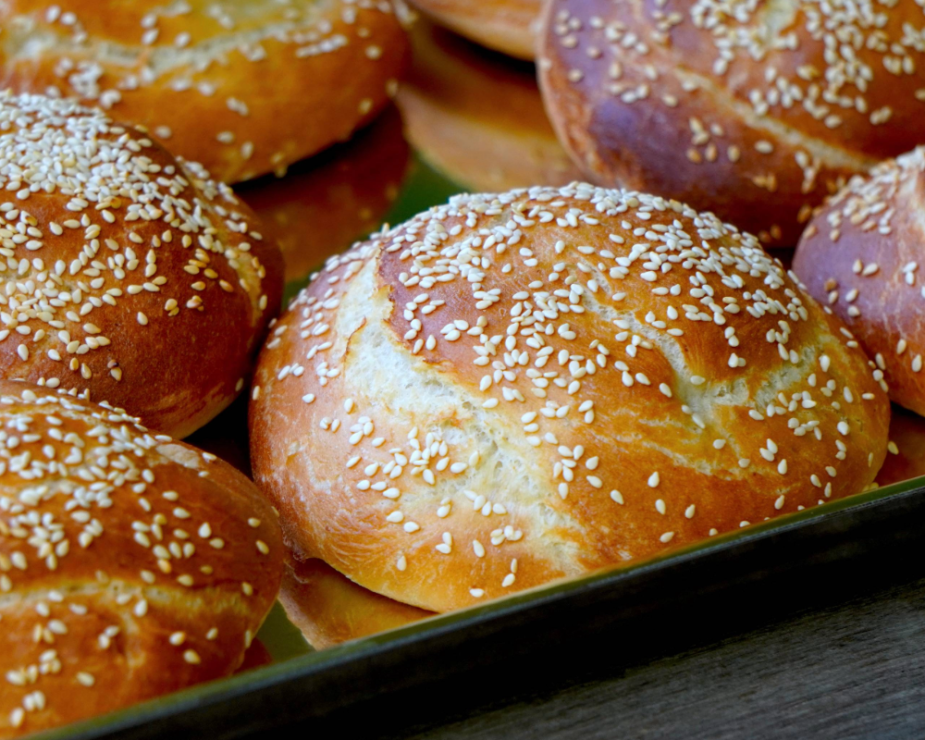
These round, sesame-sprinkled buns with their unique horizontal burst and crunchy exterior are one of a handful of Puebla’s emblematic dishes. They’re quite simple to make (though the forming and glazing will feel a bit strange your first time through). Made into cemitas compuestas–the filled and finished tortas–the true flavor of Puebla bursts forth in every bite, especially if you have some herby pápalo to layer in.
Here I’m giving the directions for making the dough with a stand mixer fitted with a dough hook. Of course, you can mix the ingredients in a bowl and then knead by hand on a floured board for 10 minutes or so, until you achieve a smooth, elastic dough.
INGREDIENTS
- For the biga (pre-ferment):
- 1/2 cup (75 grams) all-purpose flour
- 1/3 cup (75 grams) lukewarm water
- 2 1/4 teaspoons (8 grams) active dry or instant yeast
- For finishing the dough:
- 3 1/2 cups + 1 tablespoon (500 grams) all-purpose flour
- 2 teaspoons (8 grams) salt
- 1 generous tablespoon (20 grams) sugar
- 2 1/4 teaspoons (8 grams) active dry or instant yeast
- 1 1/4 cups (280 grams) lukewarm water, plus a little more as needed
- For the glaze and garnish:
- 1/2 cup water
- 1 tablespoon cornstarch
- 1 1/2 teaspoons sugar
- A couple tablespoons sesame seeds
INSTRUCTIONS
Make the biga and let rise. In the bowl of a stand mixer, stir together the ingredients for the biga until homogenous. Cover with plastic wrap and let stand at room temperature at least 4 hours, but preferably refrigerate overnight to develop the best flavor.
Make the dough and let rise. Remove the biga from the refrigerator and let stand at room temperature for an hour or so. Using a stand mixer fitted with a dough hook, on low speed mix the flour, salt, sugar, yeast and water into the biga. Once the ingredients come together, knead the dough on medium-low speed until the dough is smooth, elastic and pulls away from the sides of the bowl, about 6 minutes. Cover your dough and let rise until double in bulk, about 1 hour.
Form the cemitas and let rise. Turn the dough onto a lightly floured surface and cut into 8 equal pieces. One at a time, form the portions into balls, cupping your palm over each portion and rolling it around with a little downward pressure. (This is easiest to do if the dough has a little traction with the work surface and your palm–in other words, don’t use too much flour.) Once all are rolled, it’s best to cover with a cloth and let rest for about 10 minutes before continuing.
Now, one at a time, starting ¼ of the way in from the edge of a ball of dough, roll the pinky edge of your hand back and forth, squeezing a small part of the dough away from the larger part–you’re turning each portion into something that resembles a bowling pin. Cover with a cloth and let rest for 10 minutes.
Again, working one at a time, use your palms to flatten out one of these oddly-shaped pieces of the dough (no need to be very gentle here)--the large part needs to be about 5 inches, the small part about 2 ½ inches. Next, pick up the small part, twist it upside down and flip it over on top of the larger part. Use your palms to flatten the two pieces together (they won’t seal together, though they will stick a bit). Lay on a rimmed baking sheet lined with parchment or a silicone mat. Heat the oven to 400 degrees. Cover and let rise until double in size, about 30 minutes. Don’t let them rise more than double.
Glaze, decorate and bake. In a small pan, whisk together the water, cornstarch and sugar. Heat over medium, whisking constantly, until the mixture thickens. Remove from heat and let cool. Use a pastry brush to glaze all of your cemitas with the glaze, then sprinkle them generously with sesame seeds. Bake until richly browned, 18 to 20 minutes.



